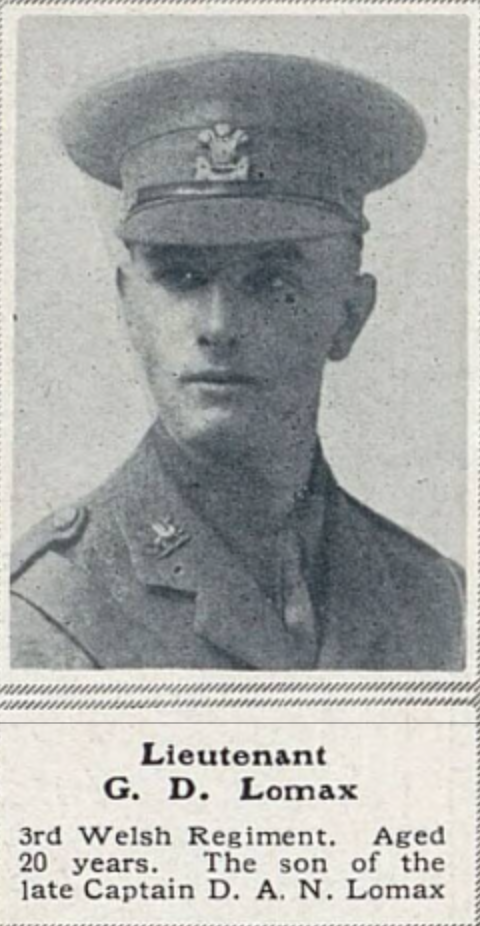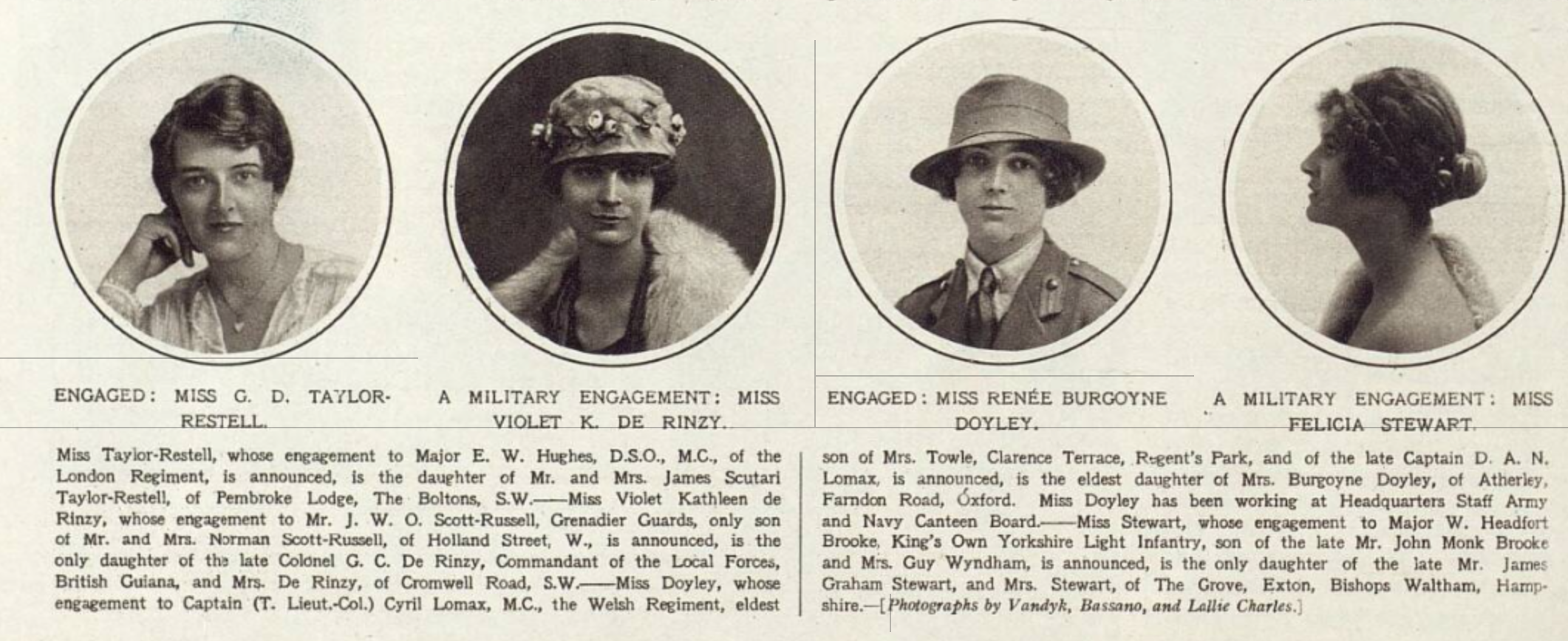David Alexander Napier Lomax
D.A.N. Lomax was born on the 28th August 1868 in Bury Lancashire. In 1881 he was a 12 year old boarder at St. John’s College, Luton. He was just 17 years old when he became the first Luton Town player to score a hat trick. He played in many positions in the team and excelled in each. His last game for Luton Town was in an F.A. Cup tie on 17th November 1888. Dan attended Oxford Military College and when he was 18 years old he became a Lieutenant in the 3rd battalion of the Northumberland Fusiliers on 29th December 1886. He was described as a “Gent”. On 2nd December 1888 he was promoted to Second Lieutenant. He became Lieutenant on 19th November 1890 when he transferred to the 41st “Welch” Regiment. The Regiment was initially called the “Royal Invalids” but gave this title up in 1787 and gained 11 battle honours in the War of 1812. It later fought in Burma, the 1st Afghan War and in the Crimea.
He married Emma Annette Morris in 1892. His first son, Cyril Ernest Napier Lomax, was born in the summer of 1893 in King’s Norton. The photo above is of Emma with Cyril. A brother, Gerald David Lomax, was born on 6th January 1895 at Manorbier, Pembrokeshire, where the Regiment was garrisoned.

The above is an extract from the log which details the movements of the 41st Regiment. The first date is the “March” and the second date is the “Arrival.” Note the 23 day march from Pembroke to Plymouth.
The Regiment arived in Plymouth in August 1895 and played it’s first football match on the 5th October, and entered the Devon Senior League and the Devon Senior Cup. D.A.N. was the team captain when in April 1896 his Regiment beat the 2nd Battalion of the 66th (Royal) Berkshire Regiment to win the Devon Senior Cup.
The Regiment finished 5th out of 11 in the League. D.A.N. also represented his regiment at cricket and seemed to have been a decent batsman. The only scorecard I can find shows he was top scorer with 40 against the local public school, the Plymouth and Mannamead College.

D.A.N. was made Adjutant of the 1st battalion of the regiment on 28th December 1898. He wrote the “History of the services of the 41st “Welch” Regiment” which is still available today. It was published on St. David’s Day 1899. He was promoted to Captain on 14th June 1899. However, the regiment’s quiet time on garrison duty was brought to an end as a war had to be won. The Regiment was shipped to Port Elizabeth and the Boer War.
The Regiment was thrust straight into the war against the Boers and the website victorianwars.com gives us the background. –
“In October 1899, the Republics of the Transvaal and the Orange Free State declared war on Great Britain. The subject of the quarrel no longer matters.
At first the war went badly for the British. Ladysmith and Kimberley were besieged and attempts to relieve them failed. By this time the 1st Battalion The Welch Regiment was on its way to South Africa. Lord Roberts had been appointed to the command and the 1st Battalion was to form part of his force. The first object was to relieve Kimberley. Skilful planning and organisation beforehand were the foundations of success in this move.
When all was ready the attack was launched. General John French with his cavalry dashed for Kimberley and relieved it whilst the infantry marched fast to cut off the Boer main force retiring from the siege. Hard marching did it and Cronje, the Boer commander, took up his position at Paardeberg in an entrenched position on the Modder River.
The actual battle was fought on the 18th February 1900, in which the 1st Battalion was heavily engaged and received special mention for a gallant charge. On the 27th February, Cronje with his men surrendered. On March the 7th, the advance was continued on Bloemfontein, the capital of the Orange Free State.
On the 10th March a strong force of Boers barred the way, at Driefontein posted on the heights. The 1st Battalion were ordered to storm the heights, whilst the Yorkshires and the Essex moved round on either flank. The ground was bare, and afforded no cover. The advance was made fifty yards at a time under heavy fire. Two more battalions were thrown into the fight, and eventually the whole line fixed bayonets and charged. The Boers fled to their horses and disappeared, our cavalry failing to round them up. In this action the Battalion lost 140 men, amongst them the Adjutant, Captain DAN Lomax, who had behaved with the greatest gallantry.”
“In his telegraphic dispatch of 11th March, Lord Roberts says ”The brunt of the fight fell on Kelly-Kenny’s division, two battalions of which – the Welsh and the Essex – turned the Boers out of two strong positions at the point of the bayonet”. Various correspondents referred in terms of praise to the work of the Welsh. The Press Association correspondent, in an admirable account wired from the field, after referring several times to the way in which the battalion advanced in face of a heavy fire, – both gun and rifle, – said “Just before dusk the Welsh Regiment gallantly rushed the position at the point of the bayonet, taking a kopje and clearing a portion of the ridge. The scene was witnessed by Lord Roberts through a telescope”. The battalion lost Captain Lomax, Lieutenant Wimberley, and 29 men killed, 5 officers and over 100 men wounded”.
Note – a kopje is a hill. The word kop comes from this. Legend has it that a when standing at the top of the Liverpool terraces, a Boer War veteran said it was so high that it reminded him of standing on the Spion kopje.
D.A.N.’s name is mentioned in despatches by Lord Roberts (dispatches dated 15th March 1900 and 31st March 1900) who adds that “he rendered conspicuously valuable service and had he survived would have brought his name prominently to notice”.
He was heard to shout “Come on the Welch” during the assault in which he died. He embodies the regimental motto “Gwell Angau Na Chywilydd” meaning “Death Rather Than Dishonour.”
I had assumed that as the British held the battlefield they were able to retrieve their fallen comrades and give them a decent burial. However, it appears that D.A.N. and his comrades are buried in a mass grave on or near the battlefield. So there is no gravestone or carefully tended cemetery, which is a great pity. The Boers, however, have their own cemetery and the descendants of the fallen Boers have photographed every grave and put them online.
There is a roll of honour (below) at the Armour Museum, Bloemfontein, Free State. D.A.N. is named at the head of his men.
Luton’s newspapers carried the story.
16th March 1900 – The Bedfordshire Advertiser.
“Fallen at the front. Captain D.A.N. Lomax, whose name is among the killed in Lord Roberts’ dispatch of March 11th, will be remembered in Luton as a football player – he and his brothers (C. and E.H. Lomax) being among the first members of the then Amateur Town Club. Captain Lomax was for ten years a pupil of the late Mr Henry Wright, St. John’s College, Luton. He joined the army in 1888 and obtained his captaincy in 1899. The “Times” says : Captain David Alexander Napier Lomax 1st Battalion Welsh Regiment, who is reported to have been killed in the fighting near Driefontein, entered the army from the militia as second lieutenant on November 19, 1890, and captain on June 14 1899. He was born on August 28, 1868.”
23rd March 1900 – The Bedfordshire Advertiser –
“A Pathetic Announcement. the following two notices appeared in the “Telegraph” on Monday, the first among the Deaths and the second in the births: “On March 10, killed in action at Driefontein, David Alexander Napier Lomax (Dan), Captain and Adjutant the 1st Battalion the Welsh Regiment (41st), youngest son of the late John Lomax, of Springfield, Bury, and 25, Upper Grosvenor-street, W. aged 31. His life to his country, his soul to God. On March 16, at 54 South-street, Park-lane, W., the wife of the late Captain David Alexander Napier Lomax, Adjutant of the 1st Battalion the Welsh regiment (41st) gave birth to a son.” As we mentioned last week, Captain Lomax was an old pupil of St. John’s College, Luton, under the late Mr H. Wright, and with his two brothers, was very popular as a football player for the Town club in its early days.”
4th May 1900 – The Bedfordshire Advertiser.
“The late Captain Lomax. Readers will appreciate the subjoined extract from M.A.P. its subject having been educated in Luton and a prominent football player in the Town team in its early days. :- probably the best-known of the Welsh Officers who have fallen in South Africa was Captain D.A.N. Lomax, the adjutant of the gallant 41st. It is not too much to say that he was far and away the most popular man in the regiment. The officers loved him, the rank and file simply adored him. He was a keen sportsman, and a capital cricketer : he was also captain of the regimental football team when they won the Devon Cup some few years ago. He has left a widow and two bonny little boys to mourn his loss. Posterity will best know him as the historian of the Welsh Regiment. Not only had he a wonderful facile pen, but he had antiquarian gifts, and was never so happy as when burrowing into the records of the past. he had, moreover, the reputation of being the second authority in the kingdom on regimental uniforms and colours. His ponderous volume on the history of the Welsh Regiment was only published a few days before he left for South Africa in October last. None will mourn more than the “Non Coms” of the Welsh Regiment, amongst whom, in consequence of his initials, he was always affectionally known as “Dan”.
The Probate records show his effects were worth £19,279 16s 7d. Typical of the man, he left a carefully constructed will and we will not be surprised to learn that others were at the forefront of his thoughts. He left money to his executors, books to the regiment plus £50 for the purchase of a silver cup as a memorial. He left £20 to the Sergeants’ Shooting Club of the regiment “in the hope that it may encourage them in the pursuit of good marksmanship”. This sounds like a reference to a standing joke. Small donations were also given to The Chelsea Hospital for Women, the Veterans Fund, the Army Temperance Association, the British Home for Incurables and to the Society for Finding Employment for Soldiers of the First Class Army Reserve. His wife and children were left the remainder save for £90.
Llandaff Cathedral (South Glamorgan today) was given several donations including £90 for the erection “of a tablet in his memory to be placed beneath the colours of the 41st Regiment”. The Cathedral had a tablet to the 41st’s fallen of the Crimean War only. D.A.N. recognised this did not include the men from other wars. The inscription on D.A.N.’s tablet reads
“To the Glory of God and sacred to the memory of the Officers, NCO’s and men of the 41st (Welch) Regiment who were killed in action or died of wounds during (1) the campaign in North America 1812-14 (2) the campaign in Burmah 1824-26 (3) the campaign in Afghanistan 1842….. This tablet was erected by bequest of the late David Alexander Napier Lomax, Captain and Adjutant of the 41st whom was killed in action at Driefontein, South Africa on 10th March 1900 as an affectionate memory of deep attachment to his old beloved Regiment.”

 Dan’s son, Gerald David Lomax left (from The Sphere 19th June 1916), died of his wounds fighting in his father’s regiment on 11th May 1915 at Ypres and is buried at Estaires Communal Cemetery. He was just 20 years old.
Dan’s son, Gerald David Lomax left (from The Sphere 19th June 1916), died of his wounds fighting in his father’s regiment on 11th May 1915 at Ypres and is buried at Estaires Communal Cemetery. He was just 20 years old.
The second son, Cyril Ernest Napier Lomax also served in the Welch Regiment. He marries Miss Doyley – their engagement was announced in the The Sketch of the 7th August 1918, below.
Cyril made it to Major-General and died in 1973.
The third son, Victor Alexander John Dan Lomax, born on 16th March 1900, six days after Dan died, is clearly named after his father. The Wrexham Advertiser of 19th May 1900 covered the christening and informs us that;
“Her Majesty the Queen gracefully signified her intention of being godmother, and she was represented by the Hon. Mrs Grant. Her Majesty sent a very handsome two-handled silver bowl, which was inscribed “Victor Alexander John Dan Lomax, from his godmother, Victoria R.I., [Regina Imperatrix] May 10th 1900.”
Victor was commissioned as a pilot officer in the R.A.F. on 29th August 1939. Victor, photographed above in 1960, died in North Tyneside in 1978 aged 78.
Dan’s wife, Emma, was to re-marry just over a year after Dan’s death to become Lady Emma Towle.
Talking of D.A.N. Lomax, The London Daily News of 20th August 1900 said;
“Captain Lomax died of his wounds, or would have been recommended for the Victoria Cross.”
Dan Lomax should be included in every conversation about Luton Town F.C. legends.
My thanks are due to;
Jenny Hocking for the photo of Emma and Victor.
The Regimental Museum of the Royal Welsh, Brecon for D.A.N.’s service dates and photograph.
eggsa.org for the Bosrand roll of honour photograph.
flickhivemind.net for the Llandaff Cathedral memorial photograph.
maltaramc.com for the 41st Movement Book extract.
Roger Walters of “Greens on Screen” for his help on Dan’s time in the South West




